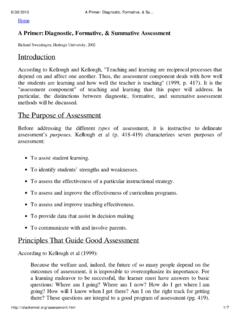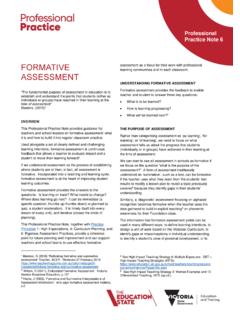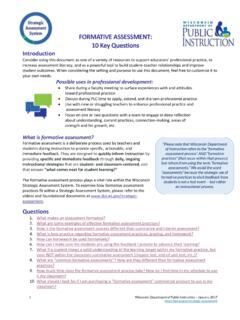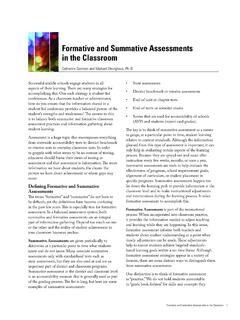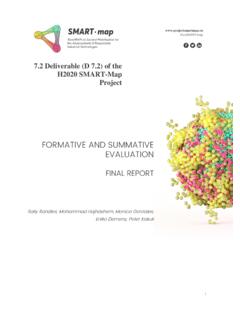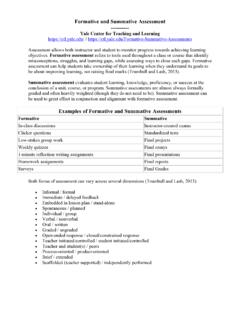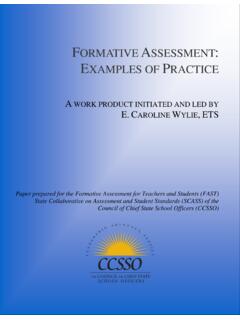Transcription of The Possibilities and Limitations of Assessment for ...
1 The Possibilities and Limitations of Assessment for Learning79 Educational Studies in Japan: International YearbookNo. 10, March, 2016. pp. 79 91 The Possibilities and Limitations of Assessment for Learning: Exploring the Theory of formative Assessment and the Notion of Closing the Learning Gap Ninomiya, Shuichi* Black and Wiliam (1998a, 1998b) demonstrate that formative Assessment is one of the most effective strategies for promoting student learning. Since the publication of their reviews, formative Assessment has gained increasing interna-tional prominence in both policy and practice.
2 However, despite this early innovation, the theory and practice of formative Assessment are currently at a crossroads. It is widely understood that problems emerge when formative Assessment is being reduced to a mini- summative Assessment or to a series of teaching techniques for coaching to improve grades and levels. On the one hand, a serious threat to the effectiveness of formative Assessment occurs when it is assimilated into larger accountability systems such as National Curriculum Assessment in England. On the other hand, a defense of formative Assessment is offered by some researchers who suggest that the threat stems from misinterpretation of the evolved form of formative Assessment .
3 In this paper, although I am alert to the rich potential of the evolved form of formative Assessment , I suggest that the threat stems not from misrepresentation but that it exists in the original theoretical framework of Black and Wiliam and the early ARG definition of Assessment for Learning. I will illustrate that this type of formative Assessment becomes convergent Assessment (Torrance & Pryor, 1998) and identify the widespread notion of closing the learning gap (Sadler, 1989) as the mechanism of convergent Assessment . I also claim that formative Assessment characterised by convergent Assessment can lead to the practice of criteria compliance (Torrance, 2007).
4 Together these claims point towards the theoretical problems of the evolved form of formative Assessment and lead to a discussion of the main dilemmas for formative Assessment : the kind of learning that is taking place, the effects of explicit learning objectives, the tension of accountability pres-sure and high-stakes summative assessments. Finally, by applying the suggestions above, this paper provides a critical analysis of recent Assessment policy in Japan, emphasizing criterion-referenced approach in classroom Assessment and proposes a pathway for developing formative Assessment : formative Assessment ; Assessment for Learning; Assessment Reform Group; closing the learning gap; criteria compliance* Wakayama University e-mail: Shuichi801.
5 IntroductionAssessment is vital to the education process. The most visible assessments are summa-tive, measuring what students have learnt and creating accountability for student performance through testing. But Assessment also serves a vital formative function through frequent, interac-tive assessments of student understanding, to identify learning needs and adjust teaching to meet the diversity of the modern the past two decades, an emphasis on formative Assessment has emerged in many parts of the world. In the context of education the term formative was introduced by Scriven (1967) to discuss curriculum evaluation and was later extended by Bloom (1969) to the improvement of educational processes including teaching.
6 Whilst several researchers have worked to advance the theory of formative Assessment (Sadler, 1989; Torrance, 1993; Torrance & Pryor, 1998), the most popular developments have been made by Black and Wiliam and the Assessment Reform Group (ARG) in UK. The landmark articles by Black and Wiliam (1998a, 1998b) demonstrate that formative Assessment is one of the most effective strategies for promoting student learning. However, despite these early innovations, the theory and practice of formative Assessment have arrived at a crossroads (Torrance, 2012).
7 For example, Marshall and Drummond (2006) explore the way in which teachers in the UK enact Assessment for Learning (AfL) practices, which is a UK programme of formative Assessment . They conclude that some practices embody the spirit of AfL, whereas others conform merely to the letter . Their research suggests that whilst the former can help prepare for future learning the latter is merely a tool for judging student performance. In more recent research Torrance (2012) points out the impasse in which formative Assessment now finds itself.
8 In spite of theoretical development and justification over many years, the practice is often limited in terms of its scope and its utilisation of the full range of possible approaches associated with formative Assessment . It tends to involve fairly mechanistic forms of activity (pp. 1 2).According to Torrance the emerging problem is that formative Assessment is being reduced to regular classroom tests, which are used for monitoring student s progress, or to a series of techniques for coaching to improve grade and test results. Many other researchers (Bennett, 2011; Klenowski, 2009; Hargreaves, 2013; OECD, 2013; Swaffield, 2011) also share this hold the view that the most serious threat to the effectiveness of formative assess - ment occurs when it is assimilated into larger accountability systems such as National Curric-ulum Assessment in England.
9 This case involves wide-ranging accountability measures, which have financial and managerial consequences for schools under significant pressure to improve test performance. In such an accountability driven culture significant tensions exist between classroom-based formative Assessment and the highly visible summative assessments, which contribute to school performance and accountability measures. As the result of the tensions, formative Assessment is often reduced to a mini- summative Assessment or to a series of teaching techniques for the other hand, a defense of formative Assessment is offered by some researchers that suggest that the threat stems from misinterpretation of the evolved form of formative assess - ment and AfL.
10 This misinterpretation is illustrated in the distinction of the spirit and the letter of AfL in Marshall and Drummond (2006). It is further discussed as the misunderstanding or misrepresentation of authentic AfL in Klenowski(2009), Swaffield(2011) and Wiliam The Possibilities and Limitations of Assessment for Learning81(in Stewart, 2012). They are disappointed that formative Assessment practice is used without a clear understanding of why, and they criticise national policy which leads to the employment of formative Assessment in an accountability culture.










